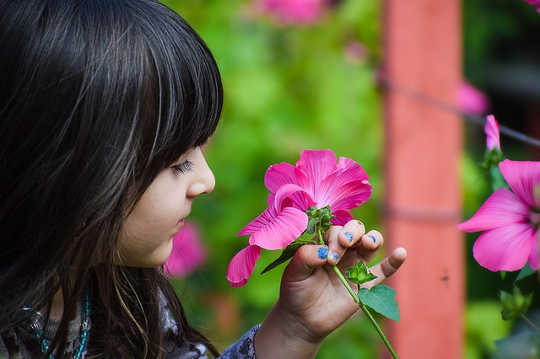
Image by khamkhor
As you begin to cultivate the art of extraordinary happiness, you begin to discover joy. Joy to me is a feeling that comes from within, whereas happiness, in its ordinary sense, is usually triggered by something in the outside world. When happiness becomes a learned skill, joy is the result. When it comes over you, it is unmistakable.
EATING LIFE WHOLE: EMBRACING JOY AND SORROW
If there is a single secret that those who live extraordinary happiness share, it is this: you must eat life whole. The good and the bad, the joys and the sorrows, the ups and downs, chocolate and lima beans. They go together, and there is no escaping the painful moments. Those you love will die; you will experience failure; tragedy will strike; your heart will break. But all will be OK—because joy will inevitably return, just as sure as pain and just as certain as the sun and moon do their dance each day.
When that finally melts into your soul—when deep in your being you understand this—your life changes and will never be the same. This may be life’s greatest paradox: when you finally embrace the suffering in your life, you no longer suffer—at least not in the same way, and certainly less and less the more your heart understands this basic truth.
HOW TO EAT CHOCOLATE LIKE A BUDDHA: MAKING JOY A WAY OF LIFE
How do you make joy a way of life? At first, most of us envision monumental changes that seem impossible to achieve. In truth, the journey is not as hard or obscure as it initially seems. By making small changes— five minutes here and there—your daily reality soon shifts.
The Buddhists also encourage creating a sangha, a group of friends who share the spiritual journey. When we unite, our journeys are easier and burdens lighter than when we travel alone. Finally, we find ways to keep the joys of life—such as eating chocolate—alive and central to each day.
SMALL STEPS TO BIG CHANGES
Changing everything all at once is not a recipe for success. In his book Do One Thing Different, solution-oriented therapist Bill O’Hanlon explains how making one, easy, doable small change typically begins a cascade of positive changes by interrupting the old mindless patterns, allowing you to make fresh, new choices. Radically forcing change by reengineering your entire life all at once rarely results in lasting change.
The paradox is that small changes often make a huge impact, much like a single pebble thrown into a lake. The reverberations stretch out far beyond the impact point of the pebble. That is exactly what happens when you start to make changes in your life. Each little change finds its way to touch multiple aspects of your life. So, go ahead and see if a chocolate a day makes a difference in your life.
CREATING YOUR OWN PERSONAL SANGHA
You may find extraordinary happiness by yourself, but it is always an easier journey when shared. Extraordinary happiness is a rebellious act—you are moving beyond the set parameters for happiness in our culture.
Buddhists refer to a group of people who come together to support each other on the spiritual journey as a sangha. Traditionally, a sangha is headed by a monk or other religious figure. If you do not already belong to a sangha, congregation, or spiritual group of some sort, you can create your own sangha with people who are already in your life.
Friends and Family
So where do you start? Friends and family are usually the first choice. Are you already close to someone you believe has a greater understanding of extraordinary happiness than yourself? That would be the best person to start with. If not, who among your family and friends might be interested in joining you on your journey? How might you entice them?
Children
Do you have children or spend much time with children? They are often like little Buddhas, living more fully in the moment than most adults. Many practice gratitude more readily than adults, enjoying a butterfly’s visit, the flower their parent might consider a weed, or the rainbows made from the sprinklers. Spend some time each week blowing bubbles, making up songs, or playing imaginary games with a child. They may help you remember some of the wisdom you lost long ago.
Spiritual and Religious Groups
Do you already belong to a spiritual or religious group? Did you at one time? All spiritual and religious traditions have wisdom and guidance to offer on the path to extraordinary wisdom plus most offer a built-in sangha. You may need to join a study group or volunteer if you belong to a large church or temple to get the type of support you need. You may even want to start a small discussion or dinner group with people from your place of worship.
Dead and Living Poets
One of the richest additions to my sangha is to read and listen to the words of others who are students of extraordinary happiness. For me, the poetry and writings of Rumi, St. Francis, the Dalai Lama, St. John of the Cross, and Martin Luther King Jr.—as well as playlists that remind me of the good in humanity and life—provide inspiration. Through their various arts, they share their struggles, and I learn how to better handle mine. Their words also provide encouragement when it would be easier to settle for ordinary happiness and the comfort of the bell curve and mindless pleasure.
Virtual Sanghas
If you look around your life and cannot find the support you need, you may have to go out and create it. You always have the virtual option: creating or joining discussion groups online.
You can also search out like-minded people by taking classes on related subjects or joining a spiritual group that fits for you. You may even find a group of coworkers who are looking for something to do at lunch.
If you keep your mind open and stay creative, you will be surprised who might find their way into your sangha.
EXERCISE: WHO’S IN YOUR SANGHA?
Using the ideas above, identify who you want to add to your sangha and how to make the connection. Identify at least five people.
JOYFULNESS AS A WAY OF LIFE
I know you have lots of good reasons for putting extraordinary happiness off—you are too busy, you or someone you love is too ill, you do not have enough money, you are not a spiritual-type person, you cannot focus when you meditate, you have too much going on in your life right now.
There is always a good, reasonable excuse—until the day you finally decide to say “no” to the rat race, “no” to ordinary happiness, “no” to the way everyone is doing things, and finally “yes” to extraordinary happiness, to joy. In the end, it is a simple decision. You decide to take another path. You can start today—the wind is perfect!
There is a famous exercise that time management speakers use to illustrate priorities and time. First, they have a volunteer fill a mason jar as full as possible with rocks. Once everyone agrees that the jar is full, the instructor has the volunteer fill the same jar with pebbles and then sand, both of which tumble down to fill the spaces between the rocks. Once everyone is again convinced that the jar is now full, the instructor has the volunteer add water. The parallels with how we choose to use our time are obvious. Your big priorities are the big rocks. If you fill your jar with lesser priorities first—represented by the water, sand, and pebbles—you will not have space for the bigger ones. Your jar will always be full. You decide exactly how you fill it. When you make extraordinary happiness your first priority, your life will be filled with great things.
DOWN TO THE LAST BITE
I want to leave you with one last little morsel to savor. Whenever you are in doubt, give life a knowing smile. Like the Mona Lisa, you’ve got a secret and the whole world can tell. You know that more is possible, that the extraordinary life is within your grasp.
Each day you take a moment to notice the colors of the flowers on your way out the door, linger for a moment when you feel a cool breeze on your face, laugh when the going gets rough, or choose gratifying work over the easy way out, you are doing it—moving toward the life we spend our lives trying to find.
©2019 by Diane R. Gehart. All Rights Reserved.
Excerpted with permission from Mindfulness for Chocolate Lovers.
Publisher: Rowman & Littlefield. www.rowman.com.
Subtitles adapted by InnerSelf
from the song: Accentuate the Positive
Article Source
Mindfulness for Chocolate Lovers: A Lighthearted Way to Stress Less and Savor More Each Day
by Diane R. Gehart Ultimately, this book invites you to play. To laugh. To love. To heal old heartbreaks. To overcome what was once impossible. To open your heart to life and all it has to offer: white, milk, and dark. The stresses of modern life often create the illusion that life is hard, painful, and lonely. You are only a few bites away from an entirely different approach to living a sweeter life.
Ultimately, this book invites you to play. To laugh. To love. To heal old heartbreaks. To overcome what was once impossible. To open your heart to life and all it has to offer: white, milk, and dark. The stresses of modern life often create the illusion that life is hard, painful, and lonely. You are only a few bites away from an entirely different approach to living a sweeter life.
(Also available as a Kindle edition.)
More books by this author
About the Author
 Diane R. Gehart, Ph.D., is an award-winning professor of Counseling and Family Therapy at California State University, Northridge, and author of numerous best-selling books for professionals, including Mindfulness and Acceptance in Couple and Family Therapy and Mastering Competencies in Family Therapy. She maintains an active psychotherapy practice in the Los Angeles area, working with adults, couples, and families to find effective and meaningful ways to address their greatest life challenges—while having some fun along the way. You can follow her on YouTube. Learn more: www.dianegehart.com and www.mindfulnessforchocolatelovers.com.
Diane R. Gehart, Ph.D., is an award-winning professor of Counseling and Family Therapy at California State University, Northridge, and author of numerous best-selling books for professionals, including Mindfulness and Acceptance in Couple and Family Therapy and Mastering Competencies in Family Therapy. She maintains an active psychotherapy practice in the Los Angeles area, working with adults, couples, and families to find effective and meaningful ways to address their greatest life challenges—while having some fun along the way. You can follow her on YouTube. Learn more: www.dianegehart.com and www.mindfulnessforchocolatelovers.com.

























